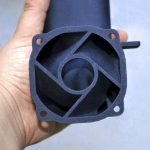Reaction Injection Molding
The last few years have seen major changes in the area of production and delivery. In addition to raw material price increases, the cost of transportation has also increased in the past 3 years. In addition, the delivery time of parts has also deteriorated due to a global shortage of raw materials. These developments are causing many companies to look for alternatives. Thus, producing products locally is becoming increasingly popular.
An additional advantage of producing locally is that the lines between producer, supplier and consumer become shorter and this often improves the communication between the links and therefore the quality of products. In addition to it being possible to start a series production with 3D printing. We are always looking for other alternatives for scaling up production. Because we believe that technology is an answer to provide an alternative to China and other manufacturing countries so that the choice to produce locally becomes even easier for companies. Because reshoring, in my opinion, is a key pillar if we want to start manufacturing again in a responsible way.
One such alternative is Reaction Injection Molding, or RIM. In 2020, we started orienting, researching, testing and optimizing, and since the beginning of April 2022, we have been offering this technique to our customers. Since then, we have delivered several successful projects.
Reaction Injection Molding
Reaction Injection Molding is a manufacturing technique in which products are made by injecting a liquid into molds. The molds allow the liquid to take the correct shape before it hardens. The end result is a product exactly in the shape of a mold that can be made within a fraction of the time of, say, 3D printing. The turnaround time of a mold can be a few seconds in some cases.
3D printed molds
Dies are normally manufactured using conventional manufacturing technologies from a light metal, such as aluminum. This forces designers to adapt their concepts to the limitations imposed by the manufacturing process. With a technology such as milling, the geometric freedom of the design is very limited; complex shapes are hardly feasible, if at all. Time for innovation! We started testing, testing and testing and now we are using our own 3D printed molds! Not only does this have the advantage of geometric shape freedom, mold costs are drastically less, mold designs are easily customizable, and instead of a production time of weeks to months for milled molds, our molds are produced within hours to days. Which ensures a short lead time.
Reaction Injection Molding is widely used for products that need to be made in large quantities.
Because of the rapid production and low cost of the material, some products can be made for very low prices, often a few cents.
Reaction Injection Molding was developed in the early 1960s and became known during the International Plastic Fair in Dusseldorp. Here, RIM was used to make a complete car out of plastic. After this, RIM was discovered mainly in America and used to make car parts such as bumpers, spoilers and interior parts.
RIM slowly disappeared from the scene in the following years. Especially the demand for high production numbers at an extremely low price drove out technology. Injection molding machines took its place. But by using 3D printed molds, the RIM machine can once again compete with the injection molding machines!

